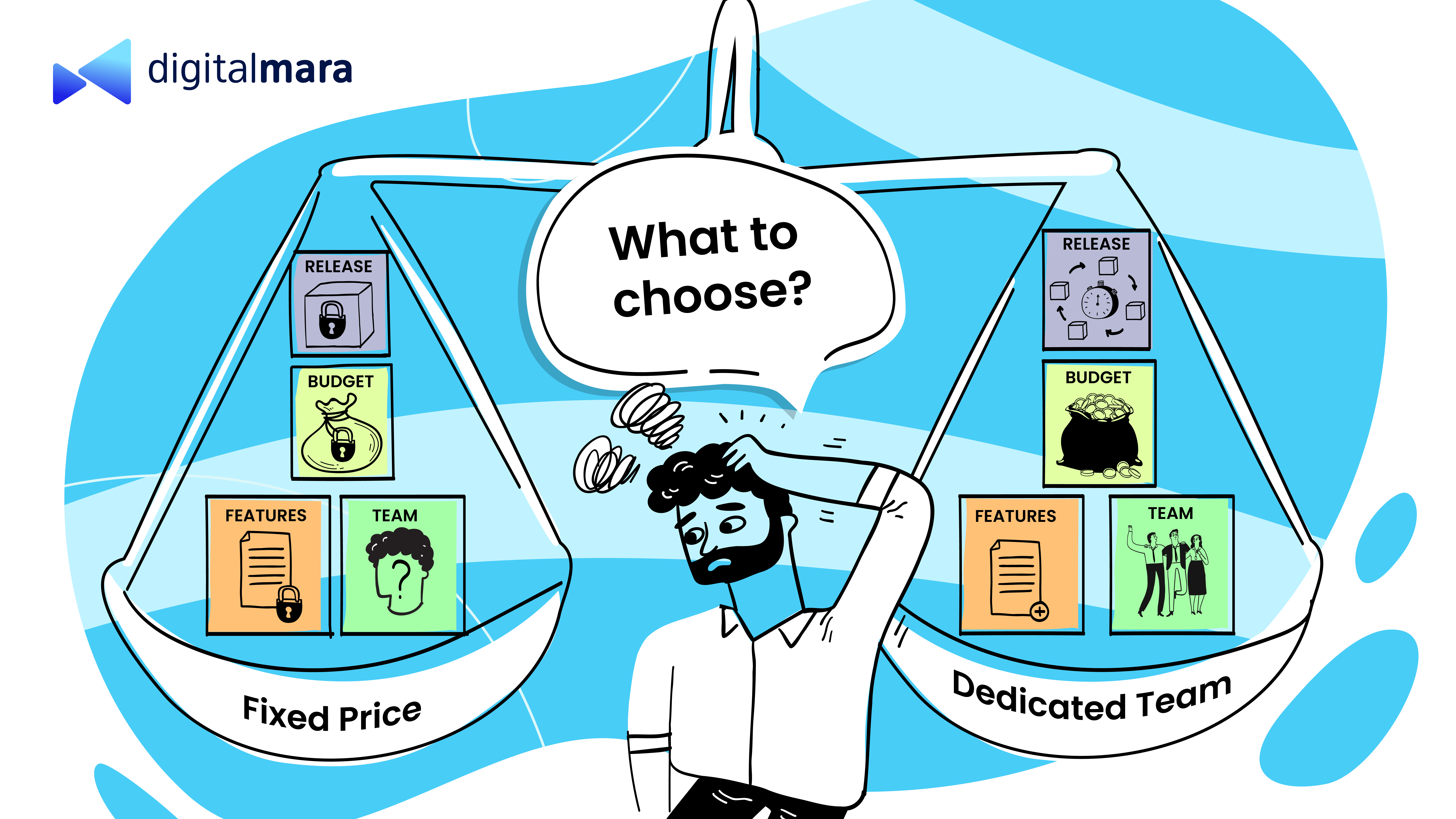You are about to start a dream project. But when choosing a vendor to collaborate with, you face a big question: Which engagement model is best? You can order a turnkey project with a fixed price, or you can pay for actual hours of effort upon completion of the work. Which should you choose to avoid overpaying, while meeting your deadlines and getting high-quality results?
It’s worth considering three basic models of engagement:
Let’s consider the pros and cons of each of these.
Fixed Price
As the term implies, this type of engagement involves a fixed price for project implementation. It sounds temptingly simple: you have agreed on the price and terms of delivery, and now you can sleep peacefully. In fact, everything may not be so rosy. A fixed price assumes that the requirements for your product are set in stone. This doesn’t mean that it won’t be possible to make changes to the specifications during the project. It’s just that any requested change will require additional estimates for implementation and an assessment of the impact the modifications may have on the rest of the project. If the changes come up late in the project, it may turn out that some functionality has already been implemented according to the old specifications.
There are advantages of this engagement model, including:
- Fixed budget and timeline.
- The vendor takes full responsibility for the quality of the product.
- The customer does not need to spend time monitoring the development process. In general, involvement is necessary only when the next stage of the project is being accepted. At the same time, the customer interacts only with the designated project manager, who controls the project stages and the timeliness of deliveries.
Some disadvantages of the fixed-price model include:
- Difficulty in making changes to the specifications after the project starts.
- The customer is often not familiar with developers involved in the project.
- Since the vendor takes on risks associated with the project, the fixed price may be higher than if the customer were to pay for the actual effort.
Conclusion:
The Fixed Price model is more suitable for projects lasting 1-2 months (i.e. small mobile applications or proof of concept). In this situation, the risk that requirements may change is minimal, and the project can easily be driven using Waterfall methodology.
Time & Material
For more than 15 years, the software world has been passionate about Agile development. This is quite understandable: we can no longer afford to work on technical specifications for months, then do a long development process following frozen requirements, then test the resulting product for another couple of months and, possibly, repeat all these steps iteratively. Today, speed to market is essential to the success of your product. Since all Agile methodologies (like SCRUM and Kanban) involve changing requirements, it is often impossible to talk about a fixed price. This is where Time & Material (T&M) comes into play. T&M assumes that the customer pays for the effort actually spent on the work. The team can have both full-time and part-time employees.
To increase the level of control over the money spent, you can consider the option of Time & Material: Fixed Budget + Scope Control. With this approach, you can set the maximum allowable budget and make sure the project doesn’t go beyond that. This is achieved by managing the scope of the project. In a nutshell, “must have” features are implemented first; then “should have” requirements are taken into the framework. Only if the budget remains, the “nice to have” features are added.
Pros of this model:
- There is no need to pre-detail all the requirements for the project. It is enough to identify the main idea and clarify those tasks that will be brought into development in the next month or two. This significantly speeds up the product release and reduces the risk of implementing features that are no longer relevant.
- The development process is more transparent.
- The customer gets to know the team and approves each team member at a preliminary interview.
- If necessary, you can pull in certain specialists on a part-time basis to perform specific tasks (for example, a security engineer, UI/UX designer, illustrator).
Cons of this model:
- It is more difficult to control the budget and deadlines.
- Part-time employees may have limited availability, meaning some tasks may be delayed.
- If it is not possible to ensure a full-time workload, there is a risk of frequent turn-over of developers, which does not contribute to the preservation of project knowledge.
Conclusion:
Time & Material, combined with Agile development methodologies, is a good choice for medium-sized projects or if the project is in the maintenance phase. In the latter case, team involvement is not required on an ongoing basis, and you can wait with feature rollouts and bug fixes.
Dedicated Team
If your project is long-term (more than six months) and it is important for you to retain knowledge within the team, look toward choosing the Dedicated Team. In essence, this engagement model is very similar to Time & Material. The main difference is that a full-time team is allocated for your project only and does not work for any other customers.
Pros of having a dedicated team:
- As with T&M, it’s easy to make changes to requirements after a project has started.
- All team members are available for full-time work, and customers personally know “their” team.
- Project knowledge is retained, as staff rotation is very low.
- The project budget is more predictable than in the Time & Material model, because you know how much the team costs per month.
- If you need to augment your in-house team, dedicated outsourcers are your best bet.
Cons of Dedicated Team model:
- You have to pay for the team on a monthly basis, whether the team has tasks or not.
- Compared to Fixed Price, the budget and project timeline should be controlled more tightly. This can be managed by either a customer representative or a vendor manager. The main thing is to determine the boundaries of the budget and systematically analyze the project metrics in order to control the progress of development.
Conclusion:
A dedicated team is the best choice for long-term cooperation, because knowledge is retained within the team, in terms of both the business domain and the codebase. As a result, tasks will be completed better and faster over time than if you had part-time specialists. So as not to burn through the budget before the release, it is recommended to hire a project manager who will regularly monitor the required project metrics and key performance indicators. The manager will not allow the team to be idle and the budget to be wasted.
So what’s the best model for you?

You should choose an engagement model based on the duration of your project, the ability to freeze requirements before the start of the development, and the presence or absence of an in-house team.
- Fixed Price can be considered if the project is small (1-2 months), and requirements and design are frozen. In this case, the team will perform all the steps required to develop and implement a turnkey solution.
- Time & Material is more suitable for medium-sized projects or a maintenance phase, where you can’t guarantee the team a full-time workload.
- Dedicated Team is typically the most appropriate model of cooperation within modern realities. The team is fully committed to your project, retaining product knowledge, increasing the speed and flexibility of development, while reducing the cost of necessary changes or new features. With this engagement model, you can also augment your internal team with external members.
DigitalMara has more than 10 years of experience in developing custom software for clients from the USA and Europe, mainly on the Dedicated Team model. We are ready to quickly allocate a team of professionals for your needs. Would you like to try it, but you’re not sure? We have a trial period for this: for one month you can check the qualifications of our software developers. And our project managers will help you bring the product to success within the specified budget. Write to us now and we will get back to you within a day.



